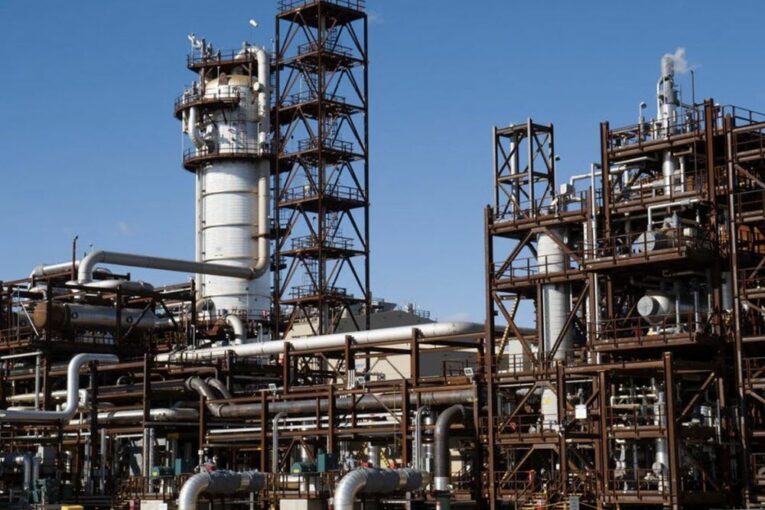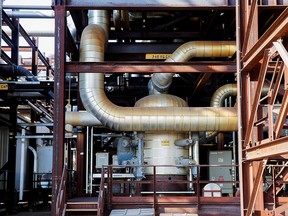
The heads of two of the country’s largest oilsands producers say Canada has fallen behind its biggest trading partner, and governments north of the border need to bolster assistance for new carbon capture and storage projects.
In an interview, Cenovus Energy CEO Alex Pourbaix and Suncor Energy interim CEO Kris Smith said Canada trails the new U.S. Inflation Reduction Act (IRA) in offering incentives to major decarbonization initiatives, such as for carbon capture, utilization and storage (CCUS) projects.
“If we were able to achieve something that looked like the American program, we would say that was a fair outcome for everybody involved and I think that would protect our competitiveness with our largest competitor globally,” Pourbaix said Monday.
“I would describe this as a bit of a crossroad for the industry, for Alberta, for Canada,” added Smith.
“We need to actually move . . . And what we don’t want to see is Canada falling behind.”
The two CEOs are appearing at the annual CERAWeek S&P Global energy conference in Houston this week, where decarbonization is a major theme.
Their comments are the latest in a series of remarks made by Canadian energy executives and business groups in the run-up to the upcoming federal spring budget.
Ottawa unveiled an investment tax credit (ITC) in last year’s budget that will cover up to half of the capital expenditures on Canadian carbon capture and storage developments. It was a key step for the oilsands as producers seek to reach net-zero emissions by 2050.
Recommended from Editorial
-

What is renewable diesel? Parkland’s planned expansion in B.C. scrapped after Biden’s U.S. green subsidies
-

Varcoe: Alberta, Ottawa continue ‘game of chicken’ on carbon capture, with little help in provincial budget
-

Carbon capture too expensive, takes too long to build: report
-

‘Canada will get left behind’: U.S. incentives for carbon capture could lure investment south
Changes passed last August by the U.S. administration boosted its existing tax credit for carbon capture projects to $85 for each tonne of stored CO2, an increase from $50 a tonne. The American incentives are part of a broader US$370-billion clean energy and climate package.
The IRA covers about two-thirds of the operating and capital costs of a CCUS development, while Canada’s investment tax credit “really only covers probably about 15 per cent of the total capital that we intend to invest,” over 30 years, Pourbaix said.
A report by BMO Capital Markets estimated the American program would cover about two-thirds of the total costs of more complex CCUS applications, compared with Canada’s investment tax credit at less than 25 per cent of total costs for such facilities.
Smith said companies are looking at making long-term investments and there’s a need for urgency on all sides to “close the loop” around financial supports.
“The competitive dynamic is shifting quickly. And while the ITC is a good first step, it’s not sufficient.”
News also emerged last week that Calgary-based Parkland Corp. was scrapping its already-announced $600-million renewable diesel project in British Columbia because the IRA program was giving American producers an advantage.
“Both (levels of) governments have to take that very, very seriously. And I don’t think any of these situations are, ‘We’re going to take our ball and go home.’ It’s all about economics,” said Pourbaix.

The two oilsands companies, along with Imperial Oil, Canadian Natural Resources, ConocoPhillips and MEG Energy, are members of the Pathways Alliance.
The group is working together on a plan to lower emissions by 22 megatonnes by 2030, and reach a net-zero target in the oilsands by 2050.
Their plan would develop a carbon capture network in the province, with a pipeline connecting 14 oilsands facilities to a storage hub in the Cold Lake area.
The project, costing $16.5 billion, would reduce emissions by 10 to 12 megatonnes a year by 2030.
Since the CCUS project was first pitched publicly in June 2021, the Pathways members have said they will require government incentives to give it the green light.
With the industry enjoying record profits last year, there’s no need to beef up government subsidies, said Simon Dyer, deputy executive director of the Pembina Institute.
He noted Canada and the U.S. have vastly different incentives and decarbonization policies in place.
Unlike the U.S., Canada has adopted a price on carbon and a new clean fuel standard — along with recent changes made to Alberta’s TIER carbon pricing system — that provide financial motivation to oilsands producers to take action, said Dyer.
“The industry is responsible for its own liabilities,” he said. “The Canadian public and Alberta public are growing increasingly tired about profitable companies trying to get the taxpayer to pay for their emissions reductions.”

Canada’s oil and gas industry is the country’s highest-emitting industrial sector.
It employs almost 500,000 Canadians directly and indirectly, and the sector was expected to pay about $50 billion last year in royalties and cash taxes to governments, Pourbaix noted.
Last week’s provincial budget didn’t include any specific large-scale incentives to match the federal investment tax credit.
However, Pathways president Kendall Dilling pointed out the province is considering expanding its Alberta Petrochemicals Incentive Program — it provides grants to such large-scale complexes — to also include the oilsands and other sectors.
With the federal government requiring the oil and gas sector to reduce emissions by 42 per cent by 2030 and attain net-zero status by 2050, “timing is critical,” said Kevin Birn, a vice-president with S&P Global Commodity Insights.
“Expediency really matters,” he said Monday.
“You have these duelling pressures to optimize environmental performance and drive down emissions, because that’s what shareholders want — and that matters to them — but so does making money.”
Chris Varcoe is a Calgary Herald columnist.
You can read more of the news on source
